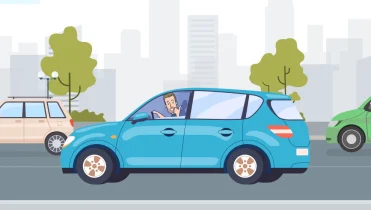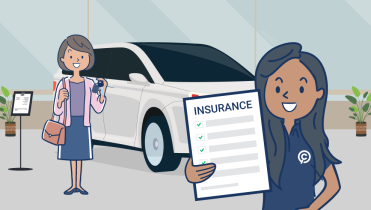less than
2 mins
- Home
- Personal Finance
- Guide
- Car Insurance For Under 25 Year Olds
Car Insurance for under 25 year olds
Key Points
If you're aged between 17 and 24 you must have held your learner’s licence for at least 12 months before you can apply for your P1, or provisional, licence (i.e. your red P-plates).
Drivers under 25 years old must also complete at least 120 hours of recorded driving time, as recorded in their logbook, before applying for their P-plates.
If you're over 25, you can try passing your Hazard Perception Test (HPT) and practical driving test as soon as you feel you're ready. You do not need to complete a logbook.
There are insurance policies designed specifically with younger drivers in mind and their premiums may be the most budget-friendly.
Securing cost-effective car insurance for drivers under 25 years old can be challenging, but understanding your options is key.
Smart Strategies for Affordable Car Insurance for P-Platers:
Add yourself as an additional driver to your parents' car insurance, keeping them as the main driver to reduce costs. Their premium will rise, but you may only need to pay the difference.
Consider a third-party policy if you don't own an expensive car.
Evaluate the benefits of cheap comprehensive cover for optimal protection.
What’s the best car insurance for under 25?
Understanding the different types of car insurance can help you make an informed decision when it’s time to hit the road on your own.
Learn more about car insurance with these guides
Includes theft, vandalism, storms, flood, hail, fire, key replacement, emergency accommodation, hire cars, accidental damage, and more.
Best for: P-platers seeking top-tier cover.
Protection against theft, fire damage, and damage to someone else's property.
Best for: P-platers needing additional cover without a hefty price tag.
Covers damage caused to someone else's vehicle or property, but not repairs to your own vehicle.
Best for: P-platers with cheaper cars or those on a strict budget.
Mandatory for every driver in Australia, providing protection for at-fault drivers involved in accidents causing injury to other people (but not property).
Factors can affect your insurance costs as a P-plater:
Gender: Men under 25 can face higher premiums due to perceived risky driving behaviour.
Location: Different suburbs may have varying rates of car theft.
Parking: Secure parking locations result in lower premiums.
Driving frequency: Frequent driving increases the likelihood of accidents.
Chosen excess: Adjusting your excess levels will affect your premium.
Discounts: You may be eligible for some discounts, such as online purchase or multi-policy discounts.
What's new in car insurance - Feb 2025
Cheaper cover: A few providers have slashed prices for comprehensive policies.
EV insurance: Cover options are expanding as more Aussies go electric.
Tech-driven savings: Telematics are driving discounts for safer drivers.
Frequently Asked Questions
Should I stay on my parent's car insurance policy or get my own?
Opting to have your car insurance policy in the same name as the car’s owner (typically your parent or guardian) is a common choice. In this case, all drivers using the car - including those on P-plates - are listed as drivers.
If you drive your parent's car, you may be able to be added as a driver on their policy. Alternatively, if the car belongs to you, setting up the policy in your own name is an option.
Regardless of the driver's licence type, it’s best that all individuals who will be driving the vehicle are listed on the policy. This avoids potential unlisted driver excesses in case of an accident.
Is car insurance more expensive for P-platers?
Generally, car insurance premiums for P-platers are higher than those for more experienced drivers. This is because less experienced drivers have a higher risk of being involved in an accident on the road. Other factors taken into account include:
age,
car type,
location,
car finance
your claims history (if any),
and data on the costs of similar claims.
The positive news is that your car insurance premiums will likely decrease as you gain more driving experience and become part of a less risky group of drivers. Another cost consideration for all drivers is your excess.
Being aware of your insurance coverage is crucial, whether you're a novice driver or an experienced one.
Why does car insurance for P-platers cost more?
Lack of driving experience statistically increases the likelihood of accidents for P-platers under 25.
What's the best car insurance for young drivers?
There’s no universal ‘best insurance’ because everyone’s personal circumstances are different.
Can I stay on my parents' car insurance policy?
Yes, staying on your parents' policy is often cost-effective, but the car must be owned by the policyholder (i.e., your parent or guardian).
Can I put my insurance under my parents' names if they don't own the car?
While putting your car insurance policy in your parent's name when you're the main driver sounds like a way to get cheap car insurance for under 25 year old drivers, this is not recommended and may lead to rejected claims or a voided policy.
Does the type of car I own affect my premiums?
Yes, factors like your car's value, repair costs, security features, popularity with thieves, and accident statistics can impact your premiums. Older cars are generally cheaper to insure. Cars with finance attached (i.e., a car loan) generally cost more to insure.
Conclusion
There’s a lot to learn when it comes to obtaining affordable car insurance for under 25 year olds. Young drivers might find the range of policies and prices overwhelming, but it’s important to explore the options available. Finding an expert to explain the ins and out to you can make a big difference.
Additional Resources
Things You Should Know
Compare Club Car Insurance is an online financial comparison service and is owned and operated by Compare Club Australia Pty Ltd (ACN 634 600 007). Compare Club does not compare all brands or all products offered by all brands.
The financial products compared on this website do not necessarily compare all features that may be relevant to you. Please check with a financial professional before you make any major financial decisions.
Any advice given here is general and has been prepared without considering your current objectives, financial situation or needs. Therefore, before acting on this advice, you should consider the appropriateness of the advice having regard to those objectives, situation or needs.
You should consider the insurers PDS prior to making the decision to purchase their product. For more information please read our Financial Services Guide (FSG) which contains further information about how our service works and how we make money.
Paul Coughran is the General Manager of Emerging Verticals at Compare Club. Paul has over 20 years of experience across a wide range of industries including Banking and Finance, Telecommunications and Energy. Paul leads a team of trusted experts dedicated to helping individuals make informed decisions about their insurance and utilities needs.

Meet our car insurance expert, Paul Coughran
Paul's top car insurance tips:
- 1
Regularly compare your insurance policies – You could be paying for cover you don’t need. Shopping around every so often can save you a fair bit, maybe even hundreds each year.
- 2
Don’t just look at the premium—check the excess too. While a higher excess might bring down your premium, remember you’ll have to fork out more if you do need to claim.
- 3
Double-check what’s included in your policy. Extras like windscreen cover or roadside assistance might not be part of the deal and could cost you more.
- 4
If you don’t drive much, consider usage-based insurance. Some policies base your cost on how much you actually drive, if you work from home or only use your car for short trips this might be a much better option.





































